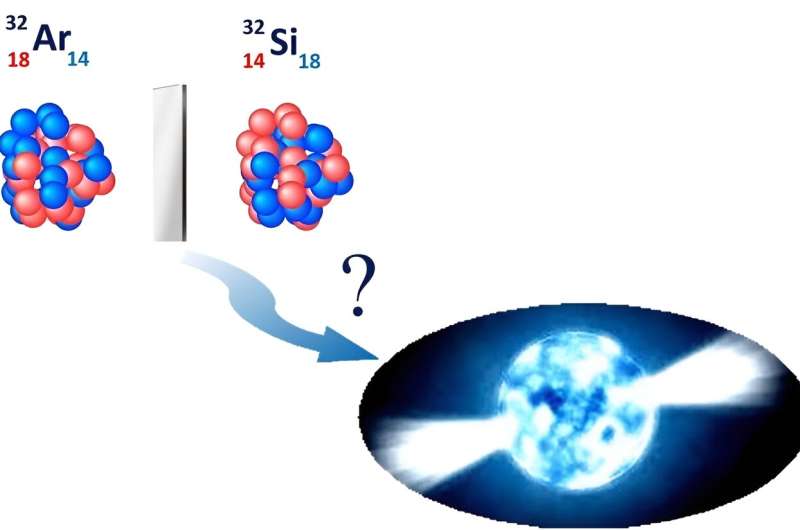This article has been reviewed according to Science X's editorial process and policies. Editors have highlighted the following attributes while ensuring the content's credibility:
fact-checked
peer-reviewed publication
trusted source
proofread
'Mirror' nuclei help connect nuclear theory and neutron stars

Adding or removing neutrons from an atomic nucleus leads to changes in the size of the nucleus. This in turn causes tiny changes in the energy levels of the atom's electrons, known as isotope shifts. Scientists can use precision measurements of these energy shifts to measure the radius of the nucleus of an isotope.
In a recent study, researchers made laser-assisted measurements of the nuclear radii of the stable silicon isotopes silicon-28, silicon-29, and silicon-30. They also measured the radius of the unstable silicon-32 nucleus, which has 14 protons and 18 neutrons. The researchers used the difference between the radius of the silicon-32 nucleus and its mirror nucleus, argon-32, which has 18 protons and 14 neutrons, to set limits on variables that help to describe the physics of astrophysical objects such as neutron stars. The results are an important step in developing nuclear theory, the study of nuclei and their components.
The paper is published in the journal Physical Review Letters.
Despite progress in nuclear theory, scientists still face long-standing challenges in their understanding of nuclei. For instance, researchers have not connected the description of nuclear size with the underlying theory of the strong nuclear force. Moreover, it is not clear whether nuclear theories that describe finite atomic nuclei can provide a reliable description of nuclear matter. This special form of matter consists of interacting protons and neutrons. Nuclear matter includes matter in extreme conditions such as neutron stars. Precision measurements of charge radii—the radius of atomic nuclei—help solve these open questions.
The researchers used laser spectroscopy measurements of atomic isotope shifts to measure the nuclear radius of different silicon isotopes at the BEam COoler and LAser spectroscopy facility (BECOLA) at the Facility for Rare Isotope Beams (FRIB) at Michigan State University.
The results provide an important benchmark for the development of nuclear theory. The charge radii difference between the silicon-32 nucleus and its mirror nucleus argon-32 was used to constrain parameters needed to describe the properties of dense neutron matter within neutron stars. The obtained results agree with the constraints from gravitational wave observations and other complementary observables.
More information: Kristian König et al, Nuclear Charge Radii of Silicon Isotopes, Physical Review Letters (2024). DOI: 10.1103/PhysRevLett.132.162502. On arXiv: DOI: 10.48550/arxiv.2309.02037
Journal information: Physical Review Letters , arXiv
Provided by US Department of Energy





















